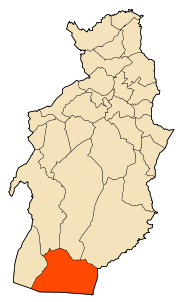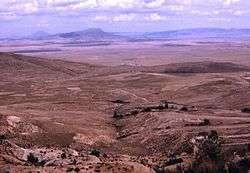Negrine

| Negrine نقرين Casae Nigrae | |
|---|---|
| Commune and town | |
|
The Old Town Of Negrine Tébessa. | |
 | |
| Country |
|
| Province | Tébessa Province |
| Government | |
| Area | |
| • Total | 619 sq mi (1,604 km2) |
| Elevation | 1,024 ft (312 m) |
| Population (2008) | |
| • Total | 9,445 |
| Time zone | CET (UTC+1) |
Negrine is a town and commune in Tébessa Province in north-eastern Algeria.[1]
Geography

Negrine is located in the Negrine Districtof Tébessa Province, Algeria. It is north of the Chott el Ghasa, near the Tunisian border and has an elevation of 321 above sea level.[2] The village population is 9445 inhabitants(2008) The landscape is generally arid and the topography is generally flat interspersed with long low mesa transecting the country side.
Average rain fall is between 5 and 20 20 millimeters with the winter being the main wet season. Average temperatures range from 7°c in Winter to 40 °C in July.[3]
History
During prehistoric times Negrine was withn the Capsian cultural area, that lasted c. 8500 BC. BC to 5400BC.[4] snail shells and piles of ash which are mixed tools and kitchen refuse and one of the defining cultural elements of Capsian, engraved ostrich eggs.[5][6][7]
Negrine was known as Casae Nigrae during the Roman, Byzantine and Vandal empires it was in the province of Numidia, North Africa. Casae Nigrae was also known as Nigrenses Maiores (30 BC - AD 640)[8] There are extensive Roman ruins in desert between Negrine and Tebessa, Algeria[9]
The area was incorporated into the Maghreb in the 7th century and today he area is home to the Nemencha, a tribe of Berber extraction.[10] [11] [12]
Bishopric
The town was the seat of a Bishopric during Roman and Vandal times. The Donatist movement was influential in the town at this time. That diocese, however, effectively ended in the 640sAD but remains a titular see in the Roman Catholic Church.[13]
Known bishops include:
- Donatus the Great[14] fl311-312.[15][16][17]
- Ianvarianus[18] fl 394-411.[19]
- Felix (Catholic) fl484.[20]
- Francis Costantin Mazzieri (26 Nov 1965 Appointed - 14 Dec 1970)[21]
- Michael Patrick Olatunji Fagun (28 Jun 1971 Appointed - 30 Jul 1972)
- Heriberto Correa Yepes(29 Jan 1973 Appointed - 9 Sep 2010)
- José Carlos Chacorowski, C.M. (22 Dec 2010 Appointed - 19 Jun 2013)[22][23]
- Robert Anthony Llanos (13 Jul 2013 Appointed - )[24]
References
- ↑ "Communes of Algeria". Statoids. Retrieved December 12, 2010.
- ↑ Elevation of Negrine,Algeria Elevation Map, Topo, Contour .
- ↑ Negrine Monthly Climate Average, Algeria.
- ↑ G. Camps, « Escargotières », dans Encyclopédie berbère, Aix-en-Provence, Edisud, 1997 (lire en ligne), p. 2683-2691.
- ↑ Simone Mulazzani (dir.), « Le Capsien de Hergla (Tunisie). Culture, Environment et économie ». Reports in African Archaeology 4. Frankfurt M., 2013, Africa Magna Verlag.
- ↑ J. de Morgan, Dr Capitan et P. Baudry, « Étude sur les stations préhistoriques du Sud Tunisien », Revue mensuelle de l'École d'anthropologie de Paris, vol. 10, 1910, p. 105-136 p105.
- ↑ E. Gobert, « Recherches sur le Capsien (lre série) », Bulletin de la Société préhistorique de France, vol. 7, no 11, 1910, p. 595-604.
- ↑ Fentress, E., R. Warner, R. Talbert, T. Elliott, S. Gillies. "Places: 334514 (Casae Nigrae)". Pleiades. <http://pleiades.stoa.org/places/334514> [Accessed: February 19, 2016 10:20 am]
- ↑ Roman ruins in desert between Negrine and Tebessa, Algeria, Roman civilization
- ↑ Paul Gaffarel, Algérie: histoire, conquête et colonisation, (SERRE EDITEUR, 2004).
- ↑ Ernest Carette, Exploration scientifique de l'Algérie. 3, Recherches sur l'origine et les migrations des principales tribus de l'Afrique septentrionale et particulièrement de l'Algérie / par E. Carette,..., Imprimerie Impériale (Paris), 1er janvier 1853.
- ↑ Camps et A. Martel, Fraichich, Éditions Peeters, 1er février 1998, lire en ligne, p. 2930-2933.
- ↑ David M. Cheney Casae Nigrae at Catholic Heirachy.org.
- ↑ Henri Irénée Marrou, André Mandouze, Anne-Marie La Bonnardière, Prosopographie de l'Afrique chrétienne (303-533) p295.
- ↑ Wace, Henry, Dictionary of Christian Biography and Literature (Delmarva Publications, Inc., 1911)
- ↑ Charles Joseph Hefele, A History of the Councils of the Church: from the Original Documents, to the close of the Second Council of Nicaea A.D. 787 (Wipf and Stock Publishers, 1 Feb. 2007 ) p179.
- ↑ Claude Fleury, John Henry Newman,The Ecclesiastical History of M. L'abbé Fleury: From the Second Ecumenical Council to the End of the Fourth Century (John Henry Parker, 1842) p250.
- ↑ Henri Irénée Marrou, André Mandouze, Anne-Marie La Bonnardière, Prosopographie de l'Afrique chrétienne (303-533) p 579.
- ↑ Saint Augustine, Letters, Volume 2 (83–130) (The Fathers of the Church, Volume 18)letter 88.
- ↑ Henri Irénée Marrou, André Mandouze, Anne-Marie La Bonnardière, Prosopographie de l'Afrique chrétienne (303-533) p 435.
- ↑ Revue des Ordinations Épiscopales, Issue 1949, Number 9
- ↑ Le Petit Episcopologe, Issue 205, Number 16,953
- ↑ Bollettino, 22 Dec 2010
- ↑ Le Petit Episcopologe, Issue 215, Number 17,868.
Coordinates: 34°29′N 7°31′E / 34.483°N 7.517°E

